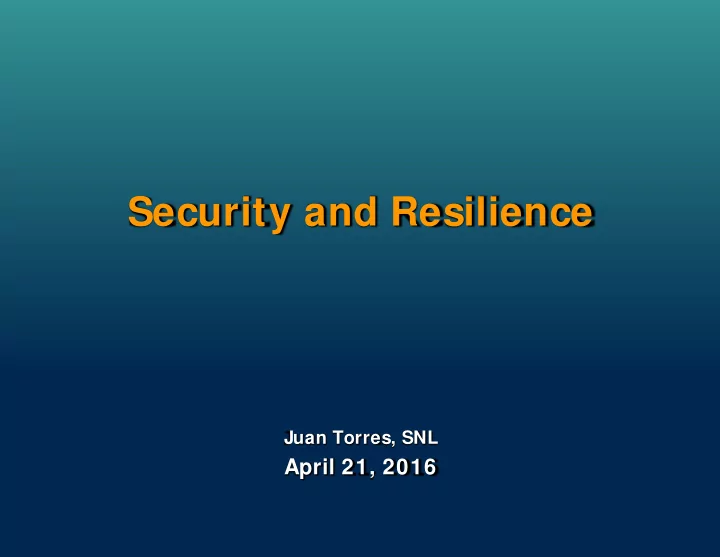

Security and Resilience Juan Torres, SNL April 21, 2016
Overview The "Security and Resilience" focus area has five main activities, based on the NIST cybersecurity framework, but expanded to all- hazards. • Improve the Ability to I dentify Threats and Hazards • Increase the Ability to Protect Against Threats and Hazards • Increase the Ability to Detect Potential Threats and Hazards • Improve the Ability to Respond to Incidents • Improve the Grid's Recovery Capacity and Time
New Jersey TransitGrid CHALLENGE ADDRESSED Major tropical storms pose a high risk to east coast critical infrastructure, impacting the economy and safe transport of the population. R&D STRATEGY Develop a resilient transportation microgrid (NJ TransitGrid) capable of providing power during a grid outage. I MPACT When completed, the NJ TransitGrid will generate more than 100 MW to service critical transportation assets operated by the NJ Transit Corporation and Amtrak. It will also supply energy and ancillary services to the grid during normal conditions and provide enhanced energy resilience during localized or regional grid outages.
Electricity Subsector Cybersecurity Capability Maturity Model (ES-C2M2) CHALLENGE ADDRESSED There is a need to improve electricity subsector cybersecurity capabilities and to understand cybersecurity posture. STRATEGY Provide a mechanism to evaluate, prioritize, and improve cybersecurity capabilities using the NIST Cybersecurity Framework. I MPACT • Provides a common set of industry-vetted cybersecurity practices. • Allows organizations to evaluate their cybersecurity practices against industry’s. • Scores compared with each organization’s desired risk tolerance.
Artificial Diversity and Defense Security (ADDSec) Ft. Belvoir / Night Vision & Electronic Sensors Extend Software Defined Networking Applicable to existing and future Moving target security architecture (SDN) energy delivery systems • Develops a framework to automatically detect • Research the extension of SDN from the local area • Provides improved situational awareness and defend control systems • Addresses NERC CIP-007-5 R3 (Malicious Code network to wide area networks • Converts static control systems into moving • Enable network randomization transparency to end Prevention), R4 (Security Event Monitoring), CIP- targets devices within an SDN setting to yield a scalable solution 008-5 R1 (Cyber Security Incident Response) Hom e I ntelligence Feeder Autom ation Substation Autom ation Transm ission Autom ation Distribution Autom ation ( DA) Generation Solar Balancing Com m unications Authority ( or W ind) Tow er AMI Collector Utility Central Cyber- Sm art Fiber Operations Therm ostat Optic Physical I nterface Line Sw itch Energy w ith Radio Managem ent Transceiver Mobile System ( EMS) Devices, Rem ote Sm art Access Meter House Cloud Other Utility’s Distribution Poles Computing Control Center Sm art Substations ( Transm ission & Distribution) Electric Vehicles W ide Area Netw ork ( W AN) Field Area Netw ork ( FAN) Hom e Area Netw ork ( HAN) Local Area Netw ork ( LAN) Local Area Netw ork ( LAN)
Future Work 1.3.4 - Industrial Microgrid Analysis and Design for Energy Security and Resiliency (ORNL, SNL) 1.3.11 - Grid Analysis and Design for Energy and Infrastructure Resiliency for New Orleans (SNL, LANL) 1.4.23 - Threat Detection and Response with Data Analytics (LLNL, LBNL, INL, ORNL, PNNL, SNL)
Recommend
More recommend